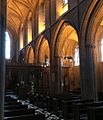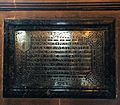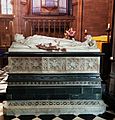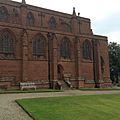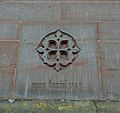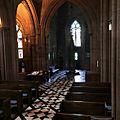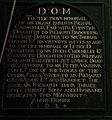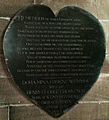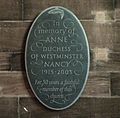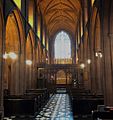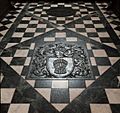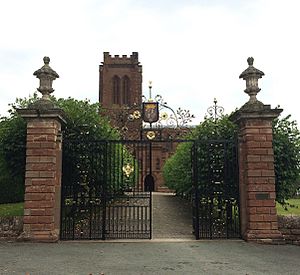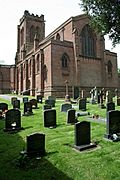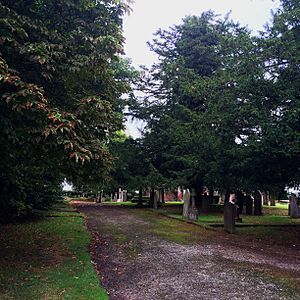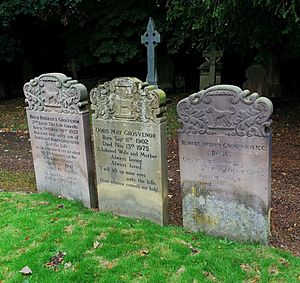St Mary's Church, Eccleston facts for kids
Quick facts for kids St Mary's Church, Eccleston |
|
|---|---|
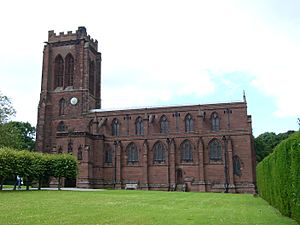
St Mary's Church, Eccleston, from the south
|
|
| Lua error in Module:Location_map at line 420: attempt to index field 'wikibase' (a nil value). | |
| OS grid reference | SJ 412 626 |
| Location | Eccleston, Cheshire |
| Country | England |
| Denomination | Anglican |
| Website | St Mary's Church, Eccleston |
| History | |
| Status | Parish church |
| Architecture | |
| Functional status | Active |
| Heritage designation | Grade I |
| Designated | 1 June 1967 |
| Architect(s) | G. F. Bodley |
| Architectural type | Church |
| Style | Gothic revival |
| Completed | 1899 |
| Construction cost | £40,000 |
| Specifications | |
| Materials | Red sandstone |
| Administration | |
| Parish | Eccleston and Pulford |
| Deanery | Chester |
| Archdeaconry | Chester |
| Diocese | Chester |
| Province | York |
St Mary's Church is a beautiful church in the village of Eccleston, England. It's located on the large estate of the Duke of Westminster, just south of Chester. This church is very important, so it's listed as a Grade I historic building. It's an active Anglican parish church, which means it's a local church for the community. The Dukes of Westminster and their families are buried in the old churchyard nearby.
Contents
History of the Church
The St Mary's Church you see today is made of red sandstone. It was built between 1897 and 1899. The famous architect G. F. Bodley designed it. The 1st Duke of Westminster paid for it, and it cost a lot of money – about £40,000 back then! The new church was officially opened in 1900.
This building is actually the third church to stand in Eccleston. It's about 100 metres (328 feet) southwest of where the older churches used to be. We know there was a church here as early as 1188. In the late 1700s, there was a very old church from the 1300s.
That medieval church was replaced in 1809 by a new one. This second church was designed by William Porden for the Earls Grosvenor. Later, in 1853, a special area called a chancel was added. But by the late 1800s, the 1st Duke of Westminster decided to build a brand new church. After the new church was finished, Porden's church was taken down. However, part of its south wall was kept as a "picturesque feature" and can still be seen in the Old Churchyard.
Church Design and Features
Outside the Church
The church is built from red sandstone blocks. It has a tall tower at the west end. The main part of the church, called the nave, has six sections. There's also a chancel (the area around the altar) with a clerestory (a row of windows high up). On the sides, there are north and south aisles, and two porches for entering. A long room called a vestry sticks out to the north.
The tower has tall openings for bells. It also has strong supports called buttresses and a decorative top with a battlement design. Above the south door, there are canopied niches with statues inside. Experts think this church shows Bodley's advanced style, even hinting at designs used for Liverpool Cathedral.
Inside the Church
St Mary's has a main area (nave) with aisles on both the north and south sides. There's also a porch on the south side. Under the tower, at the west end, is the baptistery where the font is located.
North Aisle and Chapel
At the east end of the north aisle, you'll find the organ and the vestry. There's also a large brass plaque here. It lists members of the Grosvenor family who were buried in a vault under the old church. Their burial spot in the Old Churchyard is now marked by a simple memorial with a low wall and crosses.
The church organ was built in 1899 by Gray & Davison. It was updated a couple of times, in 1910 and again in 1984.
-
A tablet remembering the church's founding by the 1st Duke of Westminster
South Aisle and Grosvenor Chapel
The east end of the south aisle holds the Grosvenor Chapel. Above its altar, you can see carved figures of Jesus, Saint Augustine, and Saint Paulinus.
Between the Grosvenor Chapel and the church's chancel is a special monument. It's dedicated to the 1st Duke of Westminster and was made in 1901. It has a tomb-chest and a canopy designed by Bodley, with a sculpted figure (an effigy) by Farmer and Brindley and Léon-Joseph Chavalliaud.
On the south wall of the Grosvenor Chapel, there's a bronze bust (a sculpture of a head and shoulders) of the 2nd Duke. There are also memorials to other Dukes of Westminster: the 3rd, 4th, and 5th Dukes. You'll also find a memorial to Captain Lord Hugh William Grosvenor, who died in the First World War. The Grosvenor Chapel has two ways to enter: a door to the churchyard and a decorative metal screen (grille) leading into the south aisle.
-
A memorial (Cenotaph) for the 1st Duke of Westminster
Tower and Baptistry
The church tower holds eight bells, which were made by John Taylor & Co in 1899.
Under the tower is the baptistry, where baptisms take place. The font (a basin for baptismal water) is made from marble from Thessaly, Greece. It has a wooden cover carved with eight saints.
In the baptistry, you can also see part of an old memorial to the Grosvenor family from 1624. This piece was moved from the previous church.
Other Church Details
Experts who wrote the Buildings of England books were very impressed by the church's furnishings. They especially liked the reredoses (decorated screens behind the altar) by Farmer and Brindley, the screens in the chancel, the organ case, and the carved ends of the benches. All the beautiful stained glass windows in the church were made by Burlison and Grylls.
Church Grounds
You enter St Mary's Church from Church Road through impressive wrought-iron gates. These gates have the Duke of Westminster's family symbol (coat of arms) on them. They are very old, from the early 1700s, and used to be at Emral Hall in Flintshire. The famous Davies Bros made them. A path lined with lime trees leads from these gates to the church's south entrance. Most of the area around St Mary's Church is covered by green lawns. The part just east of the church is used as the parish cemetery.
A path also leads from St Mary's Church to the Old Churchyard, which is about 100 metres (328 feet) northeast of the church. The walls and gates between Old Church Lane and the Old Churchyard are also protected as historic buildings.
The Old Churchyard
What You'll See in the Old Churchyard

The Old Churchyard feels a bit like a woodland, with many tall trees. In the middle, you'll find the remains of Porden's old parish church. This is a sandstone wall about 60 feet (18 metres) long and 18 feet (5.5 metres) high, with the lower parts of two windows. It's also a protected historic building.
Along the south side of this old wall are the graves of the Dukes of Westminster and other members of the Grosvenor family. In the northeast part of the Old Churchyard, there's a square area covered with gravel and surrounded by a low wall with crosses. This marks where the Grosvenor family vault used to be inside Porden's church. The names of the family members buried here are listed on a brass plaque inside the current church. The gravestone of Edward George Hugh, Earl Grosvenor (1904–1909), is also a protected historic building.
The churchyard also has ten war graves registered by the CWGC. Seven are from World War I and three from World War II. You can also find the grave of Alfred Ernest Ind, who received the Victoria Cross for bravery.
Notable Burials and Monuments
Westminster Family Graves
Along the old church wall, many members of the Grosvenor family are buried, including several Dukes of Westminster:
- Hugh Grosvenor, 1st Duke of Westminster (1825–1899)
- Lord Edward George Hugh Grosvenor (1904–1909), son of the 2nd Duke
- Hugh Grosvenor, 2nd Duke of Westminster (1879–1953)
- William Grosvenor, 3rd Duke of Westminster (1894–1963)
- Gerald Grosvenor, 4th Duke of Westminster (1907–1967)
- Robert Grosvenor, 5th Duke of Westminster (1910–1979)
- Gerald Grosvenor, 6th Duke of Westminster (1951–2016)
Site of the Old Grosvenor Family Vault
Many ancestors of the Dukes of Westminster were buried here, including:
- Sir Richard Grosvenor, 1st Baronet
- Sir Thomas Grosvenor, 3rd Baronet
- Richard Grosvenor, 1st Earl Grosvenor
- Robert Grosvenor, 1st Marquess of Westminster
- Richard Grosvenor, 2nd Marquess of Westminster
A stone tablet in this area has the Grosvenor family crest and the dates 1599 and 1894. It says: "This stone marks the resting place of those members of the Grosvenor family who were buried in a vault under the old church which was demolished in 1900 and who were reinterred in this plot and their names are recorded on the memorial tablet in Eccleston church." As it says, the names are listed on a brass plaque inside the current church.
Other Graves in the Old Churchyard
- Alfred Ernest Ind, a VC recipient (1872–1916). He worked for the Duke of Westminster.
- Sir Philip Hay (1918–1986), who was a private secretary to the Duchess of Kent.
- Dame Margaret Katherine Hay (1918–1975), who worked for Queen Elizabeth II. She was also the granddaughter of the 1st Duke of Westminster.
-
The grave of Alfred Ernest Ind, a VC recipient
See also
- Grade I listed buildings in Cheshire West and Chester
- Grade I listed churches in Cheshire
- Listed buildings in Eccleston, Cheshire



